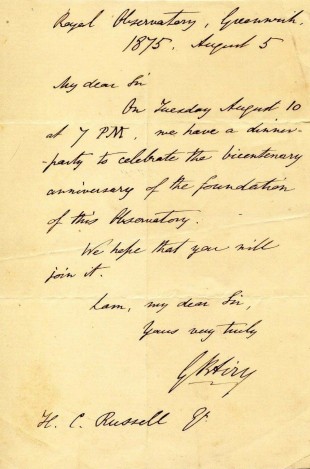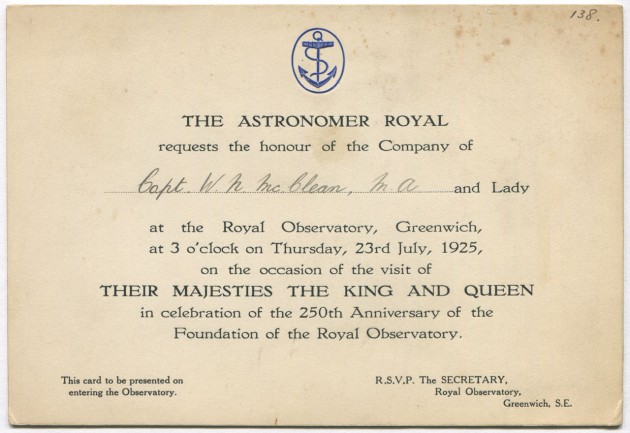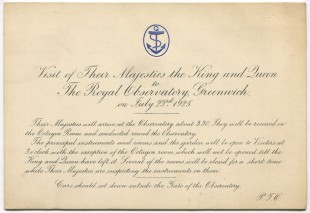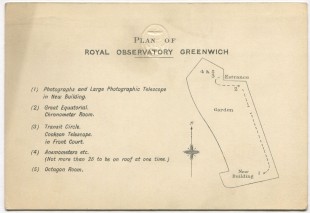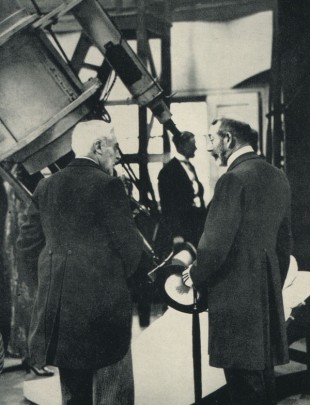…where east meets west
- Home
- Brief History
- The Greenwich Meridian
- Greenwich
(1675–1958) - Herstmonceux
(1948–1990) - Cambridge
(1990–1998) - Outstations (1822–1971)…
- – Chingford (1822–1924)
- – Deal
(1864–1927) - – Abinger
(1923–1957) - – Bristol & Bradford on Avon
(1939–1948) - – Bath
(1939–1949) - – Hartland
(1955–1967) - – Cape of Good Hope
(1959–1971)
- Administration…
- – Funding
- – Governance
- – Inventories
- – Pay
- – Regulations
- – Royal Warrants
- Contemporary Accounts
- People
- Publications
- Science
- Technology
- Telescopes
- Chronometers
- Clocks & Time
- Board of Longitude
- Libraries & Archives
- Visit
- Search
Anniversary celebrations of the Observatory’s foundation
The Royal Warrant authorising the construction of the Royal Observatory was issued on 22 June 1675. The foundation stone was laid a few weeks later on 10 August. Celebrations commemorating the Observatory’s foundation have been held every 50 years since at least 1875.
1875
To celebrate the bicentenary, Airy (the Astronomer Royal) held a dinner in the Octagon Room on 10 August. A partial record of those who were invited is recorded in the entry of that date in his journal (RGO6/26/223v).‘Dull day, beautiful sunset. … Held a solemn dinner in the Octagon Room in commemoration of the bicentenary anniversary of the foundation of the Royal Observatory, present Dr. Hooker, Professor Adams, Mr Ellery (Melbourne), Mr Russell (Sydney), Mr Stone[?], the chiefs of the Transit of Venus Expedition, and nearly all the Assistants of the Observatory.’
The dinner seems to have been a rather spontaneous affair and not long in the planning – the initiation to Henry Russell (the Chief Government Astronomer at the Sydney Observatory) having only been sent five days prior to the occasion. Of the guests, Hooker was president of the Royal Society and chairman of the Observatory’s Board of Visitors. Adams was president of the Royal Astronomical Society and vice-chariman of the Board. Stone was Airy’s former Chief Assistant and at that time, was HM Astronomer at the Cape of Good Hope. The Assistants working at the Observatory on the date the dinner was held were: Christie, Lynn, Dunkin, William Ellis, Nash, Downing, Maunder and Thackeray.
1925
Rather more planning went into the 250th anniversary celebrations. These were focussed on a Royal Visit and garden party which took place on the 23rd July. Amongst those who were invited to the various events were the delegates of the International Astronomical Union who by a happy coincidence had been holding their meeting at Cambridge from 14–22 July. During the Royal visit, the King presented the Observatory with a signed portrait of himself which was duly hung in the Octagon Room. That evening, a reception was given by the President of the Royal Society and Chairman of the Board of Visitors. On the following day, a number of guests were invited to an official luncheon given by H.M. Government at the Savoy at which the First Lord of the Admiralty took the chair.
Several of the delegates wrote up an account of their visit for the astronomical journals. Several included illustrations. References to three of the more interesting ones are given below.
The 250th anniversary of the foundation of the Royal Observatory, Greenwich. The Observatory, Vol. 48, pp. 283–291 (1925).
The Two Hundred and Fiftieth Anniversary at Greenwich. Mitchell, S. A.. Journal of the Royal Astronomical Society of Canada, Vol. 19, pp.137–142 (1925)
From the diary of a delegate. Lamson, E. A. Popular Astronomy, Vol. 34, pp.251–258 (1926)
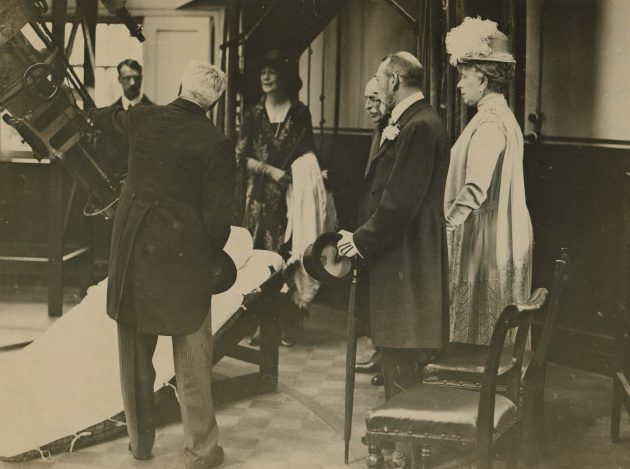
The Astronomer Royal, Frank Dyson, showing showing the 28-inch Refractor to the Royal Party. From left to right: Herbert Furner, Frank Dyson, unknown, Sir Charles Sherrington (President of the Royal Society and Chairman of the Observatory's Board of Visitors), King George V, Queen Mary
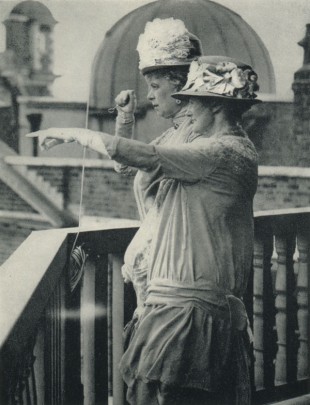
Queen Mary (rear) and Lady Dyson enjoying the view from the balcony of the Great Equatorial Building
![[23_7_25_]_le_roi_George_[...]Agence_Rol_btv1b53151798b](devblog/wp-content/uploads/2020/02/23_7_25__le_roi_George_...Agence_Rol_btv1b53151798b-630x891.jpeg)
The Royal Party on their way to the New Physical Building (from where the photo was taken) . Dyson and the King lead the way with Queen Mary and Lady Dyson following behind.
The Royal Visit was also filmed by British Pathé who have made it available to view online. Click here to view the film (which lasts just under a minute and a half). Click here for a higher resolution version from BFI. In the film, a sign carrying the number one can be seen hanging over the entrance door of the New Physical Building (South Building). This corresponds to the location numbered one on the plan above.
Reports of the Royal Visit and luncheon at the Savoy were also published by The Times, who included a list of some of those invited to the latter.
Note: The date of the Royal Visit is incorrectly recorded as 26 July in the 1926 Report of the Astronomer Royal. It also incorrectly records the date of the lunch at the Savoy as 27 July.
1975
The tercentenary celebrations were much more elaborate and ran thoughout the anniversary year. They were arranged jointly by the Royal Greenwich Observatory, Herstmonceux and the National Maritime Museum which had taken over responsibility for the original site at Greenwich. The tercentenay celebrations were the first to which ordinary members of the public were invited.
The following account of the year’s events is taken from the The Royal Greenwich Observatory Report for 1975 January to September.
‘The tercentenary of the Royal Greenwich Observatory was celebrated during 1975, marking the 300th anniversary of the appointment of the first Astronomer Royal and the establishment of the Royal Observatory at Greenwich. King Charles II’s Warrant dated 4 March 1675 appointed the Reverend John Flamsteed “our astronomical observator”, and a second Warrant dated 22 June 1675 founded the Royal Observatory.
The historical aspects of the tercentenary were featured in a number of events organized by the National Maritime Museum, which now has responsibility for the former Observatory buildings at Greenwich. At Herstmonceux, the opportunity was taken of demonstrating the current work of the Royal Greenwich Observatory to interested scientific societies and to the general public. A Tercentenary Committee, under the chairmanship of Mr. H. M. Smith, was responsible for programme planning and made detailed arrangements for the various events.
In order to give visitors a comprehensive view of the range of RGO activities, arrangements were made for five telescopes (including the INT) to be demonstrated, and 12 displays incorporating specially-prepared exhibition panels were located at appropriate points throughout the establishment. Recorded commentaries were played at some of the display points. Mr. R. H. Tucker had overall responsibility for the preparation of the exhibitions; these included displays prepared by the Chronometer Section of the Hydrographic Department and by the Geomagnetism Unit of the Natural Environment Research Council, both of which were formerly departments of the RGO and are still housed at the Observatory. A new booklet, Royal Greenwich Observatory Illustrated, was prepared by Dr. D. H. P. Jones to give a general picture of the RGO, and 15 pamphlets were produced explaining different aspects of the work and instruments in more detail.
A Press Preview, attended by 35 representatives of the local, national and foreign Press, was held at RGO on 19 June. During the week 23 to 27 June, more than a thousand members of the following scientific societies and establishments with interests allied to astronomy accepted invitations to the Observatory:
The Royal Society
The Royal Astronomical Society
Establishments of the Science Research Council
The National Physical Laboratory
The Institute of Navigation
The Worshipful Company of Clockmakers
The British Horological Institute
The Institute of Physics
The British Astronomical Association
together with representatives from establishments with whom RGO has special connections. Nearly 22000 visitors were admitted to the Observatory during the Open Days, 31 July to 17 August.
At Greenwich, the National Maritime Museum has mounted a special exhibition “300 Years of Astronomy” in the Queen’s House. The Times Publications has produced a commemorative catalogue for the exhibition, including articles written by members of RGO staff. Mr. P. S. Laurie, RGO Archivist, acted as liaison between RGO and the Museum on content and design of the exhibition; the modern section was largely the responsibility of RGO staff, Dr. D. V. Thomas acting as editor.
Two international symposia were held in celebration of the tercentenary. The first, on “The Origins, Achievements and Influence of the Royal Observatory, Greenwich, 1675–1975”, was held at the National Maritime Museum from 14 to 18 July under the auspices of the International Astronomical Union and the International Union for the History and Philosophy of Science. Papers were presented by the following RGO staff: Dr. A. Hunter, Mr. P. S. Laurie, Mr. C. A. Murray, Mr. H. M. Smith, Dr. G. A. Wilkins; and by former members of staff: Professor R. d’E. Atkinson, Mr. B. R. Leaton, Dr. D. H. Sadler and Sir Richard Woolley.
The second symposium, held at Herstmonceux Castle on 22–25 July, was on the subject of “The Galaxy and the Local Group”. A representative gathering of nearly 80 full participants, many from overseas, included 15 members of RGO staff. There were 11 invited review papers and 30 other paper contributions. Topics included the molecular content and chemical evolution of the Galaxy, the Galactic centre, classification, chemical composition and motions of the nearby galaxies, the extragalactic distance scale, and the gas content of the Local Group. Particularly stimulating discussions took place on models for the chemical evolution of the Galaxy and on the nature of the Magellanic Stream. The symposium concluded with a lively summary by Professor I. King (University of California, Berkeley) who contrasted the rapid progress that can now be expected on an annual time-scale employing current technology with the slow evolution of astronomy during the 300 years of existence of the RGO.
Guest of honour at the RGO symposium was Professor J. H. Oort, former President of the IAU, who gave an evening lecture to a wider audience on “The Nucleus of Our Galaxy”. In this he emphasized the relevance of the study of the centre of our own Galaxy to the problems currently posed by the many peculiar phenomena observed to be associated with the nuclei of other galaxies. The text of Professor Oort's lecture will be included with the proceedings of the symposium, which will be published as a Royal Greenwich Observatory Bulletin. Dr. G. A. Wilkins was responsible for the general arrangements for the symposium; the scientific programme was organized by Dr. R. J. Dickens, assisted by Professor B. E. J. Pagel and Dr. B. L. Webster.
Nearly 900 guests attended the Tercentenary Garden Party at Herstmonceux Castle on 18 July, to which all present staff and long-serving former members of RGO staff and participants in the Tercentenary Symposia were invited. The guest of honour was Her Royal Highness The Princess Anne, Mrs. Mark Phillips, who unveiled a stone bust of John Flamsteed, the first Astronomer Royal, as the inauguration ceremony for a commemorative sundial erected behind it. Designed by Mr. G. E. Taylor, the reclining equi-angular sundial is made of stainless steel and has a vertical gnomon. The 3-m diameter dial is adjusted to show Greenwich Mean Time to a nominal accuracy of one minute. The sundial was manufactured and constructed by Morfax Ltd. to an engineering design produced by the SRC Works Unit.
The Flamsteed bust was sculpted by Mr. G. Elliott, a member of the staff of Ancient Monuments Division of the Department of the Environment stationed at Herstmonceux, and grateful acknowledgment is made for permission to carry out the work. After the inauguration the Director presented Princess Anne with a commemorative Royal Observatory Plate by Wedgwood, which incorporates in its black and gold design medallion portraits of the 11 Greenwich Astronomers Royal.
Both European Architectural Heritage Year and the Tercentenary of the Royal Observatory were given royal recognition by the visit to Greenwich on 20 May of Her Majesty The Queen and His Royal Highness The Duke of Edinburgh. Her Majesty reinaugurated the 28-inch refractor, now back at its original site in a reconstructed “Onion Dome” at the Old Royal Observatory. The Engineering Department of the RGO gave advice and assistance in the re-erection of the telescope. The Royal visitors also toured the “300 Years of Astronomy” exhibition.
A reception was held jointly by the Royal Society and the Royal Astronomical Society in the rooms of the Royal Society on 17 July, when historical exhibits concerning the Observatory were displayed and a commemorative address was delivered by Professor W. H. McCrea, a former Chairman of the RGO Committee. After the address the Director of RGO presented the President of the Royal Society with a bronze copy of Mr. G. Elliott of his stone bust of Flamsteed, in commemoration of three centuries of association between the Society and the Observatory.
A service of Evensong held in Westminster Abbey on 20 July was devoted to celebrating the tercentenary of the Observatory, with lessons and hymns reflecting the triple theme of Time, Navigation and Astronomy. The lessons were read by Dr. A. Hunter and Mr. B. J. Greenhill, Director of the National Maritime Museum. Sir Bernard Lovell} delivered the Address. At a private ceremony before Evensong, Sir Richard Woolley laid a wreath on the grave of Charles II.
The parish of Burstow in Surrey, where the Reverend John Flamsteed was rector from 1684 until his death in 1719, held a Flamsteed Festival during the summer. Dr. Hunter spoke on the astronomical significance of Flamsteed's work at a memorial lecture on 6 July, and read one of the lessons in Burstow Church at a Service of Thanksgiving on 13 July, when the Bishop of Kingston conducted Evensong and dedicated a new memorial tablet to Flamsteed.
In June a BBC film unit spent three days at RGO gathering material for a 50-minute documentary to be broadcast on television in the autumn. A film unit from the Central Office of Information also visited the RGO for two days to film for overseas television.
The Royal Mint collaborated with the National Maritime Museum in the production of a set of three commemorative medals struck in gold, silver, and gilt-bronze. Each medal has a common obverse showing Flamsteed House, while the reverse designs depict Astronomy, Time and Navigation.
In collaboration with the Post Office, specially-produced commemorative covers were posted at RGO on 22 June, the 300th anniversary of the foundation of the Observatory. The covers bore the 8p postage stamp featuring Flamsteed House.
Several special publications have appeared in association with the tercentenary:
The Royal Greenwich Observatory An historical Review by Professor W. H. McCrea, FRS, commissioned by the Science Research Council.
Greenwich Observatory A History in three v volumes published by Taylor & Francis Ltd.
Vol. 1, Origins and Early History (1675–1835) by Eric G. Forbes.
Vol. 2, Recent History (1836–1975) by A. J. Meadows.
Vol. 3, The Buildings and Instruments by Derek Howse.
The Times (26 March) – Special Report: Space, Place and Time
Nature (19 June) – Special Issue containing a 26-page section on the history of British astronomy entitled 300 Years of Greenwich.’
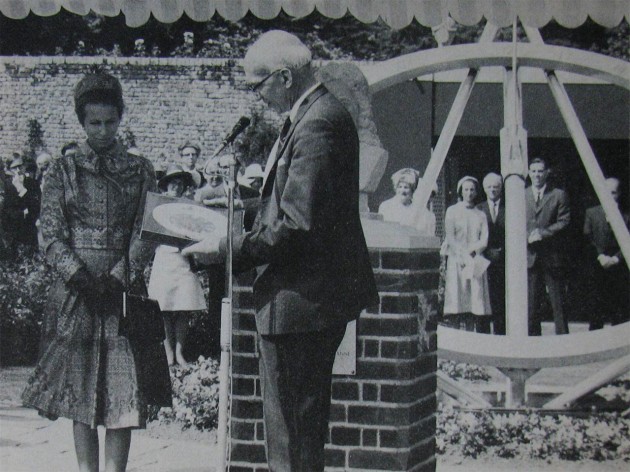
Dr. A. Hunter, Director of the Royal Observatory presenting Princess Anne with one of the commemorative plates following the unveiling of the stone bust of Flamsteed on 18 July. The tercentenary sundial can be seen on the right. Image from The Royal Greenwich Observatory Report for 1975 January to September
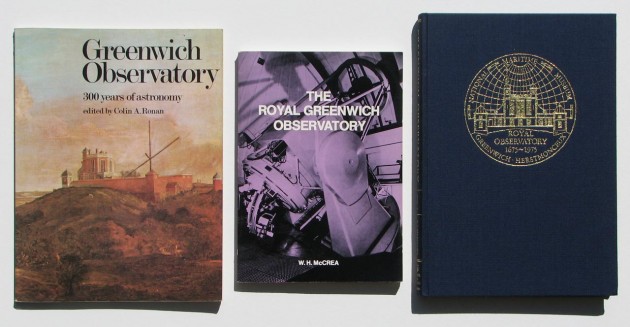
Three of the books mentioned in the above account. From left to right: The catalogue of the special exhibition 300 Years of Astronomy that was put on by the National Maritime Museum. McCrea's Historical Review. Volume 2 from the three volume set Greenwich Observatory.
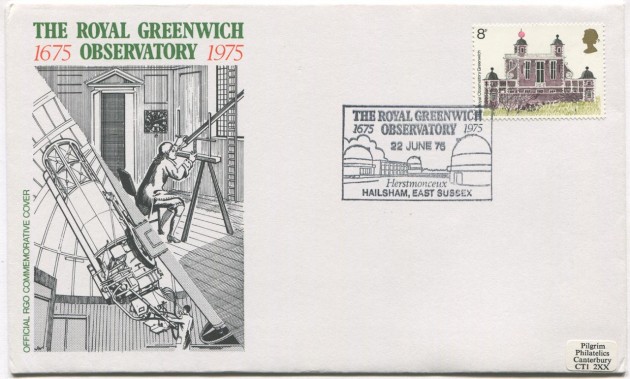
The commemorative cover issued on 22 June on the tercentenary of the Observatory's founding. By a happy coincidence, 1975 was also European Heritage year and the post office had issued a set of stamps on 23 April that included an 8p one of Flamsteed House. It was this that was used on the covers
Further Reading
Tercentenary of the Royal Greenwich Observatory. Douglas, A. V. Journal of the Royal Astronomical Society of Canada, Vol. 70, p.31 (1976)
© 2014 – 2026 Graham Dolan
Except where indicated, all text and images are the copyright of Graham Dolan
